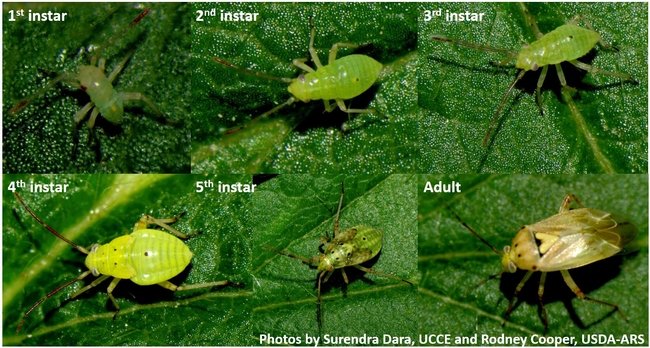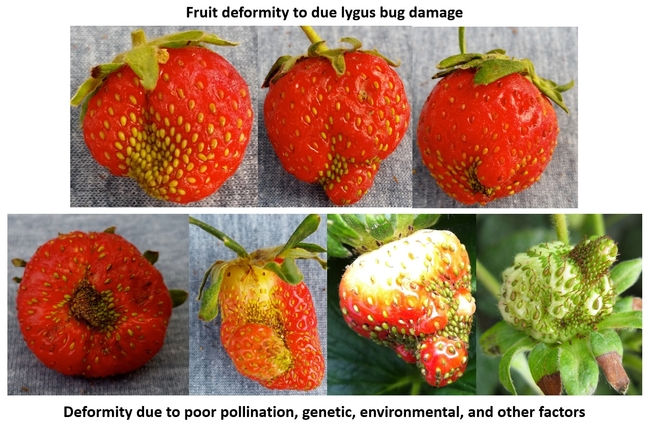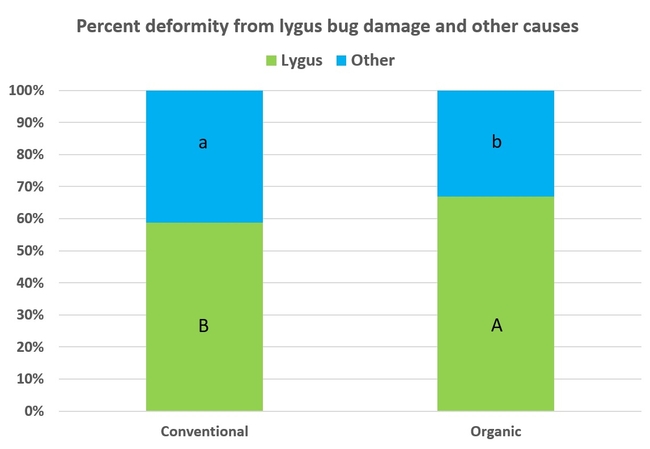Lygus bug nymphal and adult stages
Lygus bug or western tarnished plant bug (Lygus hesperus) is a major pest in California strawberries and causes significant yield losses by contributing to the fruit deformity. Lygus bug is a hemipteran insect and has piercing and sucking mouthparts. They prefer plant parts rich in proteins and lipids. Developing berries and achenes offer as a good source of nutrition in strawberries and hence they are normally seen in the inflorescence. When lygus bug inserts its mouth parts and sucks the plant juices, the tissue at the site of feeding does not grow normally resulting in fruit deformity as berries develop. Deformed berries are not marketable for fresh market and growers adopt various control strategies to manage lygus bugs and limit damage. Chemical pesticides are the popular choice for managing lygus bugs and the use of bug vacuums is also increasing in the recent years.
While the treatment threshold is one lygus nymph/20 plants, infestations are generally very high above the threshold requiring aggressive management practices. Although treatment decisions are typically made based on lygus sampling, it is not uncommon (based on personal communication with some growers and PCAs) for fruit deformity to influence treatment decisions. In light of this scenario, it is important to determine the role of lygus bug in deformed strawberries among other causes such as poor pollination, genetic factors, and environmental conditions such as cold temperatures.
Literature suggests that fruit deformity due to lygus and other causes can be determined by the size of achenes (Zalom et al., 2014). Achenes in the deformed and normal areas of the fruit are more or less of the uniform size if the deformity is due to lygus bug. Achenes are of different sizes if the deformity is due to factors other than lygus damage.
A study was conducted in September, 2015 to evaluate the role of lygus bug and other factors in strawberry fruit deformity. Deformed berries were collected from 18 conventional and 10 organic strawberry fields. Conventional fields were sampled nine times and organic fields were sampled 5 times. On each sampling date a field block was divided into four quadrants and at least 100 deformed berries were collected from each quadrant. Each berry was examined categorized as lygus- and non-lygus-related based on the size of the achenes and shape of the berry. Data were subjected arcsine transformation and statistical analysis and significant means were separated using Tukey's HSD test.
In general, lygus bug damage was significantly higher (P = 0.0002) in organic fields than in conventional fields. When the causes for the deformity were compared, the proportion of deformed berries due to lygus bug damage was significantly higher (P < 0.00001) than those due to other causes in both conventional and organic fields. It is, however, important to note that 41% of the deformity in conventional fields and 33% in organic fields was due to factors other than lygus bug. These results are important in understanding the role of various lygus bug and other factors in causing fruit deformity and making appropriate treatment decisions. Sampling the fields for lygus bugs is always the right way to make a treatment decision rather than counting on deformed berries.
Information on lygus bug biology, sampling, and management can be found at the following resources:
Lygus bug biology and damage video: www.youtube.com/watch?v=7sZu9nirOPQ
Lygus bug monitoring and treatment threshold video: https://www.youtube.com/watch?v=Z7o7fafxuhE
Lygus bug management video: https://www.youtube.com/watch?v=5-4qcvceqmU
UC IPM Pest Management Guidelines: http://www.ipm.ucdavis.edu/PMG/r734300111.html
http://ucanr.edu/articlefeedback
Reference
Zalom, F. G., M. P. Bolda, S. K. Dara, and S. Joseph (Insects and Mites). 2014. UC IPM Pest Management Guidelines: Strawberry. University of California Statewide Integrated Pest Management Program. Oakland: UC ANR Publication 3468. June, 2014.



